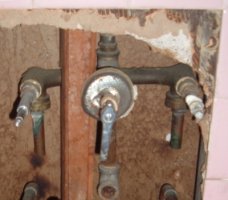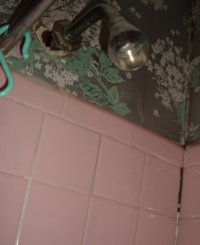Hi, referring to my attached URLs and pics, I realize that others with my 1950s pipes might have replaced them long ago, but what can i say, i'm in need of operable bath fixtures (and later i hope to add a handheld to my vintage rainshower which requires re-fastening). For now i'm prioritizing installation by a plumber of Delta Universal shower-valve R10000-UNWS & maybe T13420-SHC trim-set, which i assume are compatible with each other. To do it right, I'm hoping for him to also envelope the spout-stem in a RDS (Red Disc Seal) as well as add silicone behind it.
Since i'd also like your feedback as plumbers, i've some prep. questions:

Since i'd also like your feedback as plumbers, i've some prep. questions:
- How viable would the above be, considering the wide diameter of the 1950s Spout-Pipe you see in my pic? (Note that the gaping spout-pipe you see is female-threaded.) Can a male-adapter be threaded into it so that the 1/2" diameter copper stem of the Delta spout can somehow thereby become connectable to the adapter?
- Also, it's confusing to figure out where on earth the copper-stem of the Delta spout is packaged! Is it sold with the Universal-Valve, OR: with the Trim-Set, OR: sold separately?
- If indeed the copper spout-stem can be connected via adapter, which version of RDS is compatible to pre-empt leaks from behind? As for silicone, I own a barely used G.E. 100% Waterproof Kitchen/Bath Advanced Silicone Squeeze tube (gold-color tube), bought last year. It feels very pliable. Would that work well with the RDS?



